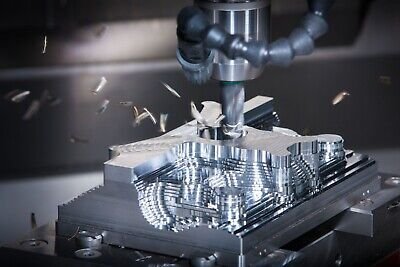CNC machining revolutionized manufacturing with its precision and efficiency, evolving from manual control to computer programming since the 1940s. Initially benefiting the aerospace sector, it has expanded to the automotive and electronics industries. Today, it integrates with IoT and AI, highlighting its crucial role in modern manufacturing and future advancements.
The Role of CNC Machining in Modern Manufacturing
CNC machining plays a pivotal role. It has become the backbone of production lines, enabling manufacturers to meet the demands of modern consumers. At its core, CNC machining automates the control of machine tools through computers, allowing for precision and repeatability that manual methods cannot achieve. This automation enhances productivity, reducing the time and labor costs associated with traditional manufacturing processes.
CNC machining’s role extends beyond mere automation. It brings unparalleled accuracy to the table, ensuring that parts are produced to exact specifications every time. This precision is crucial in industries where even the slightest deviation can lead to product failure, such as aerospace and healthcare. By minimizing errors and ensuring consistency, CNC machining enhances product quality and reliability.
Furthermore, CNC machining allows for greater design flexibility. Engineers and designers can push the boundaries of what’s possible by creating complex geometries and intricate designs that would be impossible to produce manually. This capability is particularly beneficial in prototyping, where rapid design iterations are necessary to refine products before mass production. CNC machining’s role in modern manufacturing is not just about efficiency; it’s about enabling innovation and creativity on an unprecedented scale.
Advantages of CNC Machining Over Traditional Methods
CNC machining offers several distinct advantages over traditional manufacturing methods, making it a preferred choice for many manufacturers. One of the most significant benefits is its ability to produce parts with exceptional precision and accuracy. Unlike manual machining, which relies heavily on the skill of the operator, CNC machines follow precise instructions from computer programs, ensuring consistent results every time.
Another advantage of CNC machining is its efficiency. Automated processes mean that CNC machines can operate continuously with minimal supervision, reducing downtime and increasing productivity. This capability is particularly beneficial for high-volume production runs, where speed and efficiency are critical to meeting deadlines and maintaining profitability.
CNC machining also offers greater flexibility in design and production. Complex shapes, intricate patterns, and fine details can be easily achieved, expanding the creative possibilities for designers and engineers. Additionally, CNC machines can quickly switch between different tasks and materials, allowing for rapid prototyping and custom manufacturing. This versatility is invaluable in today’s fast-paced market, where the ability to adapt and innovate is essential for staying competitive.
Common Applications of CNC Machining Across Industries
CNC machining’s versatility, including vertical and horizontal milling, makes it suitable for a wide range of applications across various industries. In the automotive sector, CNC machines are used to produce engine components, transmission parts, and intricate dashboard elements. The precision offered by CNC machining ensures that these critical components meet stringent quality standards and performance requirements.
In the aerospace industry, CNC machining plays a crucial role in manufacturing parts that demand high precision and reliability. Components such as turbine blades, landing gear, and structural elements are produced using CNC machines, ensuring that they can withstand the extreme conditions of flight. The ability to create complex geometries with tight tolerances is vital in this industry, where safety and performance are paramount.
The healthcare industry also benefits from CNC machining, particularly in the production of medical devices and implants. From surgical instruments to customized prosthetics, CNC machines enable the creation of precise and intricate parts tailored to individual patient needs. This customization is essential for improving patient outcomes and advancing medical technology. These industries are just a few examples of CNC machining’s broad applicability, highlighting its importance in modern manufacturing.
Key Technologies and Innovations Driving CNC Machining Forward
Several key technologies and innovations are driving the advancement of CNC machining, pushing the boundaries of what is possible in manufacturing. One such technology is additive manufacturing, or 3D printing. While traditionally seen as a separate process, the integration of CNC machining with additive manufacturing enables manufacturers to combine the strengths of both techniques. This hybrid approach allows for the production of complex parts with reduced material waste and increased design flexibility.
The Internet of Things (IoT) is also playing a significant role in advancing CNC machining. By connecting machines to the internet, manufacturers can collect real-time data on machine performance, identify potential issues, and optimize production processes. This connectivity enhances efficiency and reduces downtime, ultimately leading to cost savings and improved productivity.
Artificial intelligence (AI) is another game-changer in the world of CNC machining. AI-powered software can analyze vast amounts of data to optimize machining parameters, improve toolpath planning, and enhance quality control. This capability not only increases production efficiency but also enables predictive maintenance, reducing the likelihood of unexpected machine failures. These technologies, along with ongoing research and development, continue to drive the evolution of CNC machining, ensuring its relevance and impact in modern manufacturing.
Challenges and Limitations of CNC Machining
Despite its many advantages, CNC machining is not without its challenges and limitations. One of the primary challenges is the high initial cost associated with acquiring CNC machines and the software required to operate them. For small and medium-sized enterprises, this cost can be prohibitive, limiting their ability to adopt CNC technology fully.
Another limitation is the need for skilled personnel to operate and maintain CNC machines. While automation reduces the reliance on manual labor, technicians with specialized knowledge are still required to program, troubleshoot, and maintain the machines. This requirement can pose a challenge in regions where skilled labor is scarce or costly.
Additionally, CNC machining may not be suitable for all manufacturing applications. For example, certain materials or processes may require alternative methods that CNC machines cannot accommodate. Understanding these limitations and determining when CNC machining is the right choice is essential for optimizing manufacturing processes. Despite these challenges, ongoing advancements in technology and training are helping to mitigate these limitations, further enhancing the capabilities and accessibility of CNC machining.
The Future of CNC Machining Emerging Trends and Opportunities
The future of CNC machining is bright, with several emerging trends and opportunities poised to shape the industry. One such trend is the increasing adoption of smart manufacturing practices. By integrating CNC machines with IoT, AI, and data analytics, manufacturers can create intelligent production environments that optimize efficiency and quality. This approach, known as Industry 4.0, represents the next phase of the industrial revolution, offering exciting possibilities for manufacturers worldwide.
Another emerging trend is the growth of sustainable manufacturing practices. CNC machining can contribute to sustainability efforts by reducing material waste and energy consumption. Advances in eco-friendly materials and processes are opening new opportunities for CNC machining to play a role in creating environmentally responsible products.
The continued evolution of CNC technology also presents opportunities for customization and personalization. As consumer demand for unique and tailored products grows, CNC machining’s ability to produce custom parts efficiently positions manufacturers to capitalize on this trend. This potential for customization, combined with ongoing technological advancements, ensures that CNC machining will remain a vital component of modern manufacturing for years to come.
Conclusion
Now that you have a better understanding of CNC machining, its benefits, limitations, and future trends, you can see the significant role it plays in modern manufacturing. From automating complex processes to enabling customization and sustainability initiatives, CNC machining offers endless possibilities for manufacturers worldwide.




